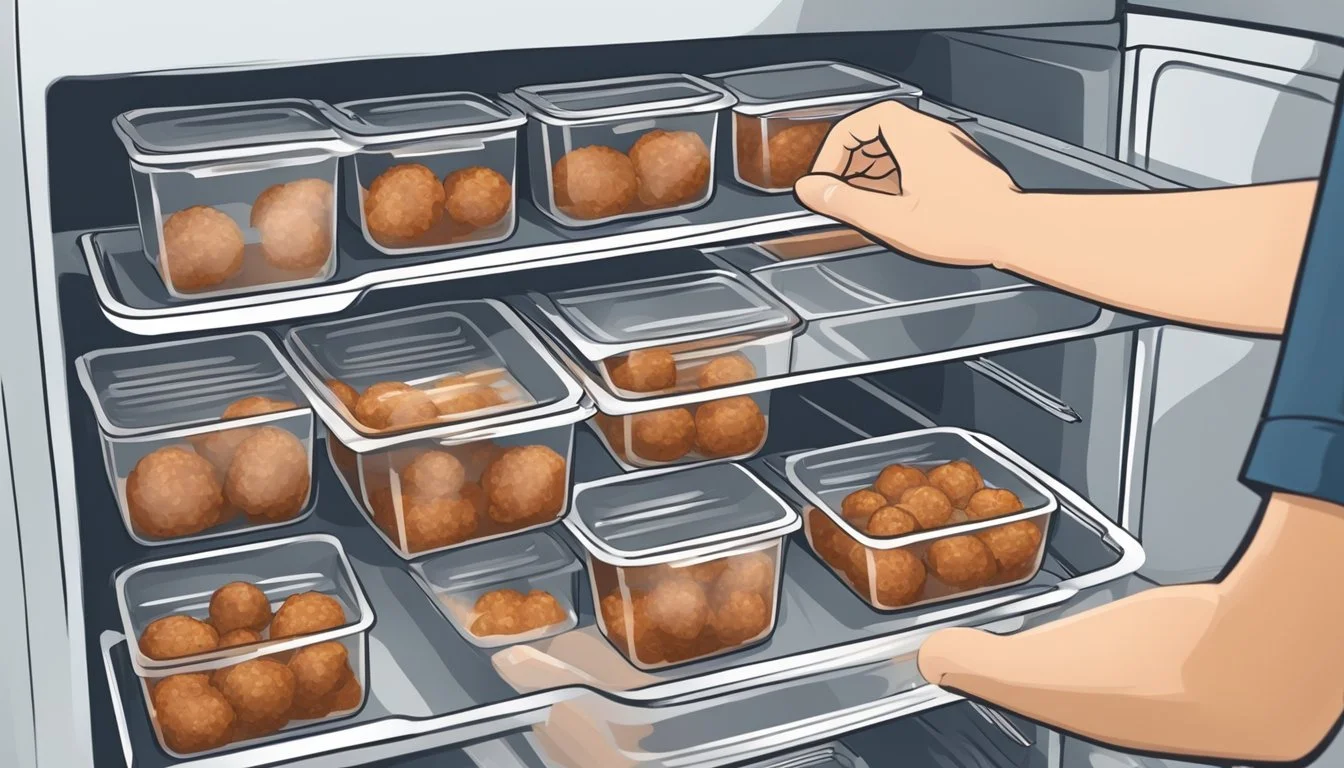How to Freeze Homemade Meatballs for Convenience
Quick Storage Tips
Homemade meatballs are a versatile and delightful addition to any meal, offering the warm comforts of a home-cooked dish. They serve as a delicious centerpiece for a family dinner, a quick addition to a pasta dish, or a hearty sandwich filler. But preparing meatballs from scratch every time can be time-consuming. By freezing homemade meatballs, cooks can enjoy the convenience of having them readily available, saving precious time on busy weeknights or when unexpected guests arrive.
The process of freezing meatballs is straightforward, enabling anyone to preserve the quality and taste of their home cooking. Whether the meatballs are raw or cooked, freezing them properly ensures they maintain their flavor and texture. Meal planning becomes more efficient as frozen meatballs can be easily defrosted and prepared, integrating seamlessly into a variety of dishes.
Freezing homemade meatballs is a smart strategy for those looking to streamline their kitchen activities. It enables cooks to prepare in bulk, reduce food waste, and manage portion control effortlessly. With meatballs stocked in the freezer, pulling together a quick and easy meal becomes a less daunting task, leaving more time to enjoy the dining experience with family and friends.
Benefits of Freezing Meatballs
Freezing meatballs is an excellent strategy for ensuring that you have a delicious and versatile comfort food readily available. Whether you're planning a weeknight meal or looking to maintain the freshness and flavor of homemade meatballs, the freezer is your ally.
Convenience for Weeknight Meals
Storing frozen meatballs in the freezer means that a significant component of a meal is prepared and waiting to be used. They can be quickly thawed and added to a variety of dishes such as spaghetti, sandwiches (What wine goes well with sandwiches?), or casseroles, making them a convenient option for busy weeknights. This eliminates the time-consuming steps involved in making meatballs from scratch, offering substantial time savings.
Portion Control and Meal Prepping
Freezing meatballs in desired portion sizes allows for efficient meal planning and can aid in portion control. You can freeze meatballs individually and then pack them into bags or containers based on the portions you'll need for future meals. This makes it easier to defrost exactly what is required, reducing food waste and supporting dietary goals.
Maintaining Freshness and Flavor
When meatballs are frozen properly, they retain their freshness and flavors. Freezing acts as a pause button, locking in the juiciness and taste until they are reheated and served. This ensures that your meatballs will remain as flavorful as the day they were made, providing consistent quality for your comfort food experiences.
Using the freezer to store meatballs is a practical approach to meal management, offering flexibility, maintaining quality, and simplifying the process of preparing nourishing meals for yourself and your family.
Selecting Ingredients for Freezable Meatballs
When preparing meatballs to freeze, selecting quality ingredients is crucial. They need to withstand freezing and thawing without losing texture or flavor.
Choosing the Right Meat
For freezable meatballs, one must select ground meat that provides both flavor and fat content for juiciness. Beef is a popular choice due to its rich taste, and an 80/20 mix of lean meat to fat is optimal. Many also add ground pork for tenderness, or choose ground turkey for a leaner option. Each meat type offers different benefits:
Beef: Rich flavor, ideal fat content
Pork: Adds tenderness and succulence
Turkey: A healthier, leaner choice
Seasoning for Longevity
The right seasoning not only enhances flavor but must also remain stable during freezing. Salt and pepper are fundamental; salt aids in preserving while pepper adds a subtle heat. Minced onion and garlic imbue the meatballs with a classic taste profile and should be used fresh for the best results. Here's a suggested seasoning combination:
Salt: 1 tsp (required for preservation)
Pepper: ½ tsp (for flavor enhancement)
Onion: ¼ cup, finely diced
Garlic: 2 cloves, minced
This mix ensures that the meatballs maintain their flavor even after freezing and reheating.
Creating the Meatball Mixture
Crafting the base mixture for homemade meatballs is foundational for their flavor and texture. The reader will discover the essentials for combining the ingredients and learn the proper technique for forming the meatballs.
Combining Ingredients
A well-mixed base ensures that each meatball is uniformly flavored and holds together well. One starts by selecting quality ground beef, which serves as the primary component of the mixture. To the ground beef, one typically adds an egg as a binding agent, which helps the meatballs maintain their form when cooked. Bread crumbs are necessary for texture; they absorb moisture from the other ingredients like milk, which also tenderizes the meat.
To infuse the mixture with flavors synonymous with classic Italian cuisine, it is common to include Italian seasoning and garlic powder. For freshness and color, finely chopped fresh parsley is often mixed in. The ingredients should be evenly distributed throughout the beef, ensuring that every bite is packed with taste and adheres to the desired mouthfeel.
Ingredient Purpose Ground beef Main component, provides structure and flavor Egg Binder, helps ingredients adhere Bread crumbs Absorbs moisture, aids in texture Milk Tenderizes the meat, adds moisture Italian seasoning Adds classic Italian flavor Garlic powder Provides aromatic depth Fresh parsley Adds a pop of color and fresh flavor
Forming the Meatballs
Once the ingredients are thoroughly combined into a homogenous mixture, they are ready to be shaped. Handling the meat should be done with care to avoid compacting it too tightly, as this can lead to dense and tough meatballs. Scoop a small amount of the mixture and gently roll it between the palms to create a rounded shape, typically aiming for a size that is approximately 1 1/2 inches in diameter.
The forming process is crucial for consistency in cooking. Uniform meatballs will cook evenly, which is essential for achieving an ideal texture throughout. A common practice is to lay the formed meatballs on a baking sheet, leaving enough space between them to prevent touching, ensuring they retain their shape during the freezing process.
Pre-Freezing Preparation
In preparing to freeze homemade meatballs, careful arrangement on the baking sheet and proper flash freezing are crucial steps to prevent freezer burn and ensure meatballs retain their quality.
Arranging Meatballs on Baking Sheet
Before freezing, one should lay out the meatballs on a baking sheet in preparation for flash freezing. The baking sheet can be lined with parchment paper to prevent sticking and to facilitate easy removal post-freezing. To maintain consistency in size, a cookie scoop can be used to shape the meatballs before they're placed on the baking sheet. Ensure that meatballs are spaced adequately to prevent them from sticking together.
Flash Freezing Basics
Flash freezing involves placing the prepared baking sheet with the meatballs into the freezer for a short period, typically around 2 hours, until they're fully firm. This step is crucial in preserving the meatball's shape and texture. Once flash-frozen, the meatballs are transferred to a freezer-safe container or a freezer bag with excess air removed. This method significantly reduces the chances of freezer burn and maintains the quality of the meatballs during storage.
Freezing Meatballs
When preparing meatballs for freezing, one has the choice between storing them cooked or uncooked. The appropriate storage method will ensure the meatballs retain their quality when thawed and prepared for consumption.
Storing Cooked vs. Uncooked
Cooked Meatballs: Freezing cooked meatballs can save on future preparation time, as they simply need to be reheated. To freeze cooked meatballs effectively, one should:
Cook the meatballs according to a preferred recipe.
Allow them to cool to room temperature to avoid condensation inside the packaging, which can cause freezer burn.
Arrange them in a single layer on a parchment-lined baking sheet without touching to prevent them from sticking together.
Place the baking sheet in the freezer for 1-2 hours or until the meatballs are fully frozen.
Once solid, transfer the meatballs to a freezer-safe container or airtight freezer bags, label with the date, and store.
Raw Meatballs: Freezing uncooked meatballs is ideal for preserving the fresh taste and allowing the flavors to meld while in the freezer. The process entails:
Preparing uncooked meatballs from a chosen recipe.
Laying them out on a parchment paper-lined baking sheet, spaced so they do not touch.
Flash freezing the meatballs for 1-2 hours until solid.
After freezing, placing the meatballs into a freezer-safe container or airtight freezer bags to prevent air exposure.
Using Freezer-Safe Containers
The use of freezer-safe containers is crucial to extend the shelf life of frozen meatballs. Whether the meatballs are raw or cooked, it is important to use:
Airtight Containers: These minimize air exposure that could lead to freezer burn.
Freezer Bags: They should be heavy-duty to prevent leaks and odors from seeping in or out. Bags can be laid flat to save space.
For best results, meatballs should be consumed within 3-4 months of freezing. When storing, always label the containers or bags with the contents and the freezing date.
Thawing and Reheating Options
For optimal taste and texture, thawing and reheating meatballs should be carried out with care. Choosing the correct method preserves the quality of the meatballs, ensuring they are just as enjoyable as when they were first prepared.
Refrigerator Thawing
Thawing meatballs in the refrigerator is the safest method. It maintains a low, consistent temperature that reduces the risk of bacterial growth. To thaw meatballs, simply take the desired quantity from the freezer and place them in the refrigerator. This process can take several hours, or overnight, depending on the size and quantity of meatballs.
Quick Thawing Techniques
For a faster thawing method, one can use a microwave. Place the frozen meatballs in a microwave-safe dish and use the microwave's defrost setting, checking periodically to ensure they do not start to cook. Another method is to seal the meatballs in a watertight plastic bag and submerge them in cold water, changing the water every 30 minutes to ensure continuous thawing.
Reheating in Oven, Microwave, and Stovetop
Meatballs can be reheated in an oven, microwave, or on a stovetop.
Oven: Preheat to 350°F (175°C). Place meatballs on a baking sheet and bake until heated through, which can take about 10 to 15 minutes.
Microwave: Arrange meatballs in a microwave-safe dish, cover with a lid or a damp paper towel to retain moisture, and heat using the reheat setting or at 50% power in 30-second increments until thoroughly warmed.
Stovetop: In a saucepan, gently heat meatballs on low to medium heat with a bit of sauce or water to prevent them from drying out. Stir occasionally until they are completely heated through.
Serving Suggestions and Pairings
When ready to serve, homemade frozen meatballs can be paired with a variety of sauces and dishes to create a satisfying meal. The versatility of meatballs makes them a perfect canvas for different flavors and culinary styles, from classic Italian pairings to the comfort of a submarine sandwich.
Meatballs with Sauce Varieties
Frozen meatballs can be elevated with sauce varieties that accentuate their flavor. They can be simmered in:
Marinara Sauce: A classic choice, ideal for spaghetti and meatballs or served as an appetizer with a side of this tangy, herby tomato sauce.
Cream Sauce: Swedish meatballs traditionally bask in a rich and creamy sauce, often including a touch of allspice and served over noodles or with mashed potatoes.
Other Sauces: Meatballs are versatile and can be paired with various pasta sauces, from a spicy arrabbiata to a velvety vodka sauce or even a pesto for a herby twist.
Integrating Meatballs into Different Dishes
Meatballs can be integrated into a multitude of dishes beyond the expected. They are ideal for:
Pasta: Toss meatballs in with your favorite pasta and sauce for a hearty meal.
Soups: Meatballs can add protein and flavor to a range of soups, from Italian wedding soup to a simple minestrone.
Pizza Toppings: (What wine goes well with pizza toppings?) Chopped meatballs make a flavorful topping, adding a twist to the traditional pizza night.
Creating Meatball Subs and Sandwiches
Meatball subs and sandwiches are a satisfying meal that can easily be constructed with frozen meatballs.
Meatball Sub: Place meatballs in a hoagie roll, smother them with marinara sauce, sprinkle with mozzarella, and broil until bubbly.
Sandwiches: A warm baguette filled with meatballs and your choice of condiments, from pickled veggies for a Banh Mi style to provolone cheese and peppers for an Italian flair.
These pairings transform the frozen meatball from a simple ingredient to the star of the meal.
Maintaining Quality in the Freezer
When freezing homemade meatballs, one should focus on preserving the texture and flavor to enjoy a meal that tastes as good as when it was first prepared. Taking the right steps before and during storage is key to maintaining quality.
Preventing Freezer Burn
Freezer burn occurs when air reaches the meat's surface and dries it out, leading to a tough and dry texture upon reheating. To prevent this:
Use airtight packaging: Wrap the meatballs tightly with plastic wrap or aluminum foil.
Vacuum sealing: If possible, vacuum seal the meatballs to eliminate air exposure completely.
Portion size: If preparing a big batch of meatballs, freeze them in portions to avoid thawing more than needed at once.
Labeling and Rotation
Proper labeling and rotation are crucial for keeping track of how long meatballs have been frozen and to ensure they are used while at their best quality.
Label clearly: Write the type of meatball and the freezing date on the container or bag.
First in, first out: Place the newest batches of frozen meatballs behind the older ones to use the oldest stock first.
By following these measures, one can freeze homemade meatballs effectively, ensuring they remain fresh and delicious until they are ready to be enjoyed.
Health and Safety Considerations
When freezing homemade meatballs, ensuring their safety for later consumption is crucial. This section addresses proper internal cooking temperature before freezing, and the significance of understanding the shelf life of meatballs once stored in the freezer.
Measuring Internal Temperature
It's important that meatballs reach a safe internal temperature before they are frozen to kill any harmful bacteria. The meatballs should be cooked to an internal temperature of 160 degrees Fahrenheit, which can be accurately measured using a meat thermometer. Insert the thermometer into the center of the meatball to check the temperature. This step is essential, no matter if the meatballs will be frozen raw or cooked.
For reference:
Raw meatballs: Must be cooked to 160°F before freezing
Cooked meatballs: Verify they’ve reached 160°F before cooling and subsequent freezing
Understanding Freezer Shelf Life
The longevity of meatballs in the freezer is affected by consistent freezer temperatures and proper storage techniques. Meatballs can be safely frozen for 3-4 months; however, for the best quality, it's recommended to consume them within this timeframe. Always store meatballs at 0 degrees Fahrenheit or lower, and ensure they're placed in an airtight container or sealed freezer bag with excess air removed to prevent freezer burn.
Key points:
Freezer temperature: Should be at or below 0°F
Shelf life: Best within 3-4 months
Storage methods: Use airtight containers or sealed freezer bags
It's important to let meatballs reach room temperature before freezing to avoid raising the freezer's internal temperature, which can lead to increased ice crystals and possible food spoilage. Always label meatball packages with the freezing date and contents, which helps in managing the inventory and ensures that one uses the oldest items first to maintain quality and safety.







